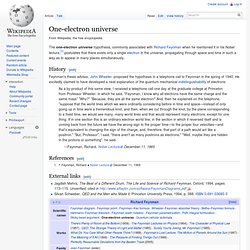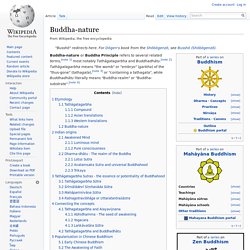

One-electron universe. The one-electron universe hypothesis, commonly associated with Richard Feynman when he mentioned it in his Nobel lecture,[1] postulates that there exists only a single electron in the universe, propagating through space and time in such a way as to appear in many places simultaneously.

History[edit] Feynman's thesis advisor, John Wheeler, proposed the hypothesis in a telephone call to Feynman in the spring of 1940. He excitedly claimed to have developed a neat explanation of the quantum mechanical indistinguishability of electrons: As a by-product of this same view, I received a telephone call one day at the graduate college at Princeton from Professor Wheeler, in which he said, "Feynman, I know why all electrons have the same charge and the same mass" "Why? " "Because, they are all the same electron! " References[edit] External links[edit] Jagdish Mehra, The Beat of a Different Drum, The Life and Science of Richard Feynman, Oxford, 1994, pages 113–115. Dzogchen « Natural Mind. Chökyi Nyima Rinpoche The ability to dissolve thoughts is essential to attaining liberation, says renowned Dzogchen teacher Chökyi Nyima Rinpoche.

Devotion and Pure Perception are two principles that lie at the root of Vajrayana practice that lead beyond confusion to thought-free wakefulness. Meditation training, in the sense of sustaining the nature of mind, is a way of being free from clinging and the conceptual attitude of forming thoughts, and therefore free from the causes of samsara: karma and disturbing emotions. Please do not believe that liberation and samsara is somewhere over there: it is here, in oneself. Thought is samsara. Compared to the other life forms in samsara, we human beings do not suffer that much. Ego-clinging is simply a thought. Deluded thinking forms karma and disturbing emotions. If you want to attain liberation and omniscient enlightenment, you need to be free of conceptual thinking.
The bottom line is this: we need to know how to dissolve thoughts. Tathāgatagarbha doctrine. Buddha-nature or Buddha Principle refers to several related terms,[note 1] most notably Tathāgatagarbha and Buddhadhātu.

[note 2] Tathāgatagarbha means "the womb" or "embryo" (garbha) of the "thus-gone" (tathagata),[note 3] or "containing a tathagata", while Buddhadhātu literally means "Buddha-realm" or "Buddha-substrate". [note 4] Etymology[edit] Tathāgatagarbha[edit] The term tathāgatagarbha may mean "embryonic tathāgata", "womb of the tathāgata", or "containing a tathagata". Compound[edit] The Sanskrit term tathāgatagarbha is a compound of two terms, tathāgata and garbha: tathāgata means "the one thus gone", referring to the Buddha.